A Selfridges and Reference Studios exhibition.
By Rahim Attarzadeh
Photographs by Rafa Yuste
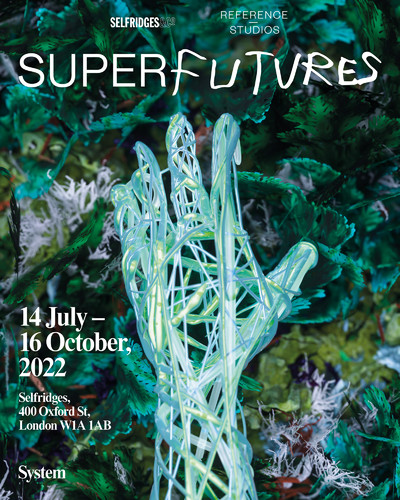
Visions for the future. As we continue to imagine and create a more sustainable future at Selfridges, the SUPERFUTURES exhibition sees us question our current way of thinking and being, to help us visualize and shape that future.
The exhibition suggests a future that is hybrid. One in which distinctions between humans and our relationships to the things around us are not absolute or binary. An awe-inspiring world of cohabitation and coexistence.
SUPERFUTURES invites us to embrace this fluid and organic way of thinking, to help us, collectively, build a positive future. A future in which we can live better and brighter. A super future.
Where were you brought up?
Mumi Haiati: I was born in Düsseldorf but I am Persian. I am Persian-German; I’m more Persian than German!
What were some of your earliest memories of fashion growing up?
Mumi Haiati: I used to dream of becoming a fashion designer or an actor, then I ended up in fashion circles because right after high school I moved to London. I was exploring and found myself hanging out in eccentric circles. My first encounters with fashion actually started when I was really young, around 13 or 14. I was already going clubbing because of my beard and how I looked; that was one of the few benefits I had at the time. I was this outcast from Düsseldorf and I wasn’t really part of that Arab-Turkish group, but I wasn’t also part of the Germans either. I was just figuring me out. London, like Berlin, has always been seen as this melting pot of creativity.
Did subcultures or the counterculture at the time make you feel a stronger connection to fashion and in turn bring out a freedom of self-identity?
Mumi Haiati: Subcultures or counterculture, that whole early hip-hop scene like Wu-Tang Clan and watching The Lost Boys was what really resonated with me. I was smoking my first joint and feeling awful! Wearing that whole Versus by Versace and DKNY look. I wasn’t aware of those American brands that were really connected to the whole gangsta-rap scene, like Tommy Hilfiger. I felt like a male version of Aaliyah. But I was always in between these two worlds. It was either the hip-hop scene or the Berlin techno scene. Techno was going on next door in Cologne. There is a legendary label called Kompakt that started there. They were throwing these underground parties. It was more free-spirited than I was used to and I felt a closeness to that freedom of self-expression. Not being overwhelmed by the feeling of homophobia during that period. The queer nightlife scene was really prevalent in Cologne. There were moments where it felt like I was living a double life and different subcultures really helped me in garnering my identity. It helped make me become who I am.
‘There were moments where it felt like I was living a double life and different subcultures really helped me in garnering my identity. It helped make me become who I am.’
How did you transition from wanting to be a designer to working in communications?
Mumi Haiati: It happened instinctively, like a mission or a calling. I looked at what I was good at, and I thought that people just feel comfortable with me. I can deal with all sorts of humans, even when they are terrifying! I am fascinated by humans. At the same time, I’ve always felt an urge to create a new kind of platform.
What laid the foundations for Reference Studios?
Mumi Haiati: Reference Studios was built with the idea of creating a new platform, a coms agency or whatever you want to call it. Vogue Runway once called us a ‘fashion organization’ and that was fun. I wanted to create something that really speaks the language of the young. I want young people to understand that we aren’t just commenting on them – we are a part of them. That was why we launched Reference Festival. It is a physical extension of our world, a place for special projects, and a space to showcase interdisciplinary forms of creativity.
Considering Berlin’s rich cultural history, how important a role did the city play in formulating your success?
Mumi Haiati: It was key to our success starting out. Being located in Berlin, a city without any fashion infrastructure, it was my creativity that significantly helped to make Reference successful in becoming relevant on a global scale. I was inspired by the city’s unique energy. This formula and my free spirit set the direction. All an agency needs to do today is to activate those buzzwords like community building or interdisciplinarity. Acting as a platform, those elements came naturally to me. That’s what laid the foundation for Reference years ago. It helped us grow and expand during a pandemic.
How do you go about finding clients? I’m sure the process has changed since the creation of Reference Studios.
Mumi Haiati: They find us nowadays, which is great. I think what brings us together often are mutual values within our ecosystem. Of course, this wasn’t the case in the beginning. When I started in my office in an immigrant neighbourhood in Berlin, I had racks of clothing hanging from the ceiling. I then transformed it into a showroom and I was working with a quite a few underground brands like Komakino and then also Faith Connexion, which Christophe Decarnin from Paco Rabanne and Balmain was behind. The clients built up from there. Everyone was obsessed with this idea of authenticity and I think this is what drove the references behind Reference Studios. It was this idea of us being the reference, the epicentre of ‘cool’. Nowadays it’s beyond that. It was a learning curve. The ‘epicentre of cool’ – just saying that feels like an insult now! When does the desire for ‘cool’ cease to be desirable?
‘Everyone was obsessed with this idea of authenticity and I think this is what drove the references behind Reference Studios. It was this idea of us being the reference, the epicentre of ‘cool’. Nowadays it’s beyond that.’
Let’s talk about the SUPERFUTURES project at Selfridges and your involvement. Can you
talk me through how the project came about?
Mumi Haiati: Selfridges reached out to us. They had been investigating this idea of ‘superfutures’ and wanted to explore how to bring this concept to their audience in an interesting way. They had seen our Protopia edition of our festival in Berlin in September last year, which was dedicated to a whole range of futurist scenarios, and developed between us, Berlin art institution Schinkel Pavillon, and Monika Bielskyte. I think Selfridges felt inspired by this, sharing the same vision or thoughts on the future, on the immediate future. That’s how the conversation started.
When people consider the future of retail, they immediately talk about e-commerce, but what do you think about the future of physical retail and Selfridges’ role within that?
Mumi Haiati: The store has aways been super progressive in its approach. My favourite example of this was when they had around 500 naked people shot by American photographer Spencer Tunick as an art performance in the store back in 2004. They were far ahead of their time, bridging the intersection between fashion, retail and contemporary art. We immediately felt a resonance with that as it’s not too different from what we are trying to do now at Reference. A lot of people have only started that conversation in more recent times. They were really brave to do that in 2004. SUPERFUTURES follows this trajectory, demonstrating their willingness to experiment and test the parameters of what retail can mean now and in the future. For us, the SUPERFUTURES exhibition is a way to visually and creatively convey how Selfridges sees the future and add some of our Berlin-driven savoir-faire.
‘For us, the SUPERFUTURES exhibition is a way to visually and creatively convey how Selfridges sees the future and add some of our Berlin-driven savoir-faire.’
Talking of Berlin. The city feels as if it is always undergoing some sort of permanent aesthetic revolution.
Mumi Haiati: Since the Roaring Twenties!
It is still a nucleus of culture nowadays. It has materialized the underground into the mainstream.
Mumi Haiati: Of course. It was the centre of the world in the 1920s. In the 1970s and 1980s, David Bowie and Iggy Pop spent time here. There was a pop-culture element, and nowadays Berghain is like the Studio 54 of our generation. The kids still want to move to Berlin just to be able to go to Berghain every weekend and get lost there. When you refer to the underground, I immediately think of Demna. His aesthetic is just so Berlin-driven and I think it is inspired by the city’s Brutalist aesthetic. Most of his muses are people based in Berlin. I would know as half of them are our creative tribe and friends!
If Reference Festival is not just another fashion week, what is it?
Mumi Haiati: I think it’s a platform for special projects. I don’t like categorization because by doing that we hinder new projects from happening. All the major brands have a special-projects department these days. They are creating books, exhibitions, and all sorts of design collaborations. They do so many things. We are anything that falls into the ‘in-between’; we love to say ‘in-between’ because it defines us. Or as Hans Ulrich would say, an unrealized project. We have been realizing those unrealized projects since the festival’s inception in 2019.
Curated by Agnes Gryczkowska, learn more about the SUPERFUTURES exhibition below.

Where are you based?
GENTLE MONSTER: Seoul.
Describe what you do.
GENTLE MONSTER: Eyewear brand.
Please describe your concept. What are your stylistic ambitions and references?
GENTLE MONSTER: Our core message is expressed eloquently through surrealism and hyperrealism, so with the Giant Head, we wanted to provide a fresh experience by obscuring the boundary between reality and fantasy.
What does your installation for SUPERFUTURES say about the future?
GENTLE MONSTER: The Giant Head is a prototype for the future of technology and of mankind. In our prediction, people will inevitably be inseparable from technology, which will make it more humanistic and humans more mechanical. Giant Head exaggerates this duality by focusing on the hyperreal details of the human face and the unsettling movements of a machine mimicking humans. Our question is, which do you fear more: a future where technology allows machines to become clones of human life or one where humans are equivalent to automated machines?
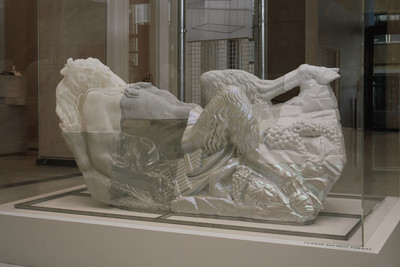
Where are you based?
Oliver Laric: Berlin.
Describe what you do.
Oliver Laric: Artist.
Please describe your concept. What are your stylistic ambitions and references?
Oliver Laric: It is hard for me to summarize the piece in a few sentences, but it prioritizes matters of process and technique over imagery and meaning.
What does your installation for SUPERFUTURES say about the future?
Oliver Laric: The work is suggestive of a future full of hybrid forms in which mutations, crossovers, and an interplay between species, materials, shapes, and times are common.
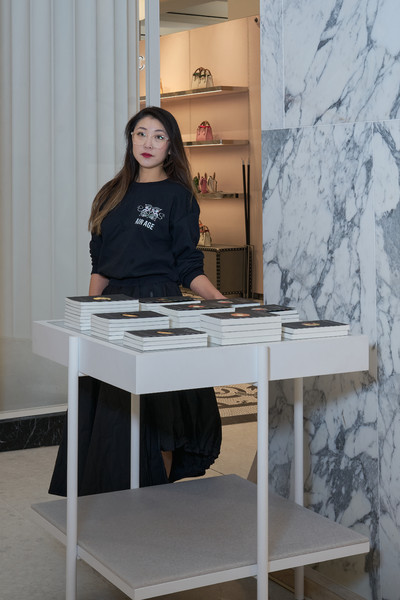
Where are you based?
Ignota: London.
Describe what you do.
Ignota: Creative publishing house.
Please describe your concept. What are your stylistic ambitions and references?
Ignota: Ignota’s store aims to offer visitors the chance to be open to the possibility of transformation and sustenance. Employing an associative logic, the space offers magical objects, such as books that act as portals to multiple consciousnesses, alongside a curated selection of artworks.
What does your installation for SUPERFUTURES say about the future?
Ignota: The space brings objects and technologies from the past together with works and proposals that look towards the future to hack the linear contemporary narrative logic that looks only one way: a world view built on Westernized cosmotechnics of a singular, stable reality with the human at the centre, which can no longer withstand its own contradictions and mythology.

Where are you based?
Joey Holder: London.
Describe what you do.
Joey Holder: Artist.
Please describe your concept. What are your stylistic ambitions and references?
Joey Holder: Working with scientific and technical experts, I make immersive, multimedia installations that explore the limits of the human and how we experience non-human, natural and technological forms. I investigate complex systems that dissolve the ‘natural’ and the ‘artificial’. Consumer products, virtual biology and aquatic creatures are incorporated into a web to challenge our perception of evolution, adaptation and change.
What does your installation for SUPERFUTURES say about the future?
Joey Holder: Our future depends upon our relationship with other living things. The work focuses on the complex web of interrelationships between the macro and microscopic worlds, above and below the soil. The installation suggests a national-history museum with amalgamations of specimen-rich collections in cabinets of curiosities. Our Western natural history has fixed categories and taxonomies, but most life on earth is undiscovered, and what is observed is part of a mutating reality, not that which is fixed by our limited systems.
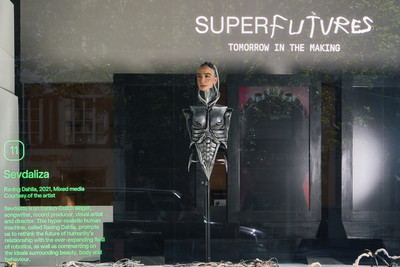
Where are you based?
Sevdaliza: The Netherlands.
Describe what you do.
Sevdaliza: Creator.
Please describe your concept. What are your stylistic ambitions and references?
Sevdaliza: Dahlia represents the ‘perfect’ woman. Serving as a vehicle to rethink the future of humanity’s relationship with the ever-expanding field of robotics, Dahlia also comments on the transitory ideals surrounding beauty, body and behaviour.
What does your installation for SUPERFUTURES say about the future?
Sevdaliza: I will fight for a future that is pluriform. I will always celebrate differences. Dahlia must become redundant in a near future.
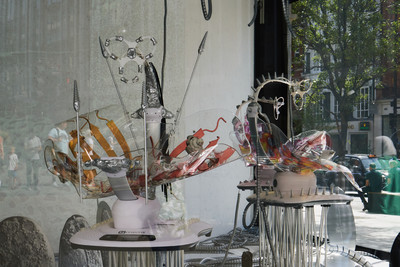
Where are you based?
Katja Novitskova: Amsterdam.
Describe what you do.
Katja Novitskova: Artist.
Please describe your concept. What are your stylistic ambitions and references?
Katja Novitskova: Pattern of Activation (mamaroo nursery, dawn chorus) features a group of electronic cradles that appear to have become organic. Swinging in robotic motion and scanning the world with laser pointers, they watch a slideshow presentation of machine-vision algorithmic readings of animal images – in the wild and under the microscope – and other surprise signals. They are surrounded by flat egg-like sculptures of C. elegans roundworm embryos and one adult worm (commonly used in laboratory experiments).
What does your installation for SUPERFUTURES say about the future?
Katja Novitskova: My work aims to synthesize current trends into an intuitive, nonlinear reading of the future. I focus on the integration of biology and technology through computation, and where this might lead us. I use visual data and online image archives to build narratives and bring visual forms into the physical dimension, creating installations and works that help fix speculation in reality.

Where are you based?
Monira Al Qadiri: Berlin.
Describe what you do.
Monira Al Qadiri: Visual artist.
Please describe your concept. What are your stylistic ambitions and references?
Monira Al Qadiri: My works are based on scientific illustrations of the chemical composition of benzene, a hydrocarbon in petrol.
What does your installation for SUPERFUTURES say about the future?
Monira Al Qadiri: The larger-than-life inflatable sculptures I’m showing aim to highlight our current dependence on fossil fuels, and how modern society is addicted to them. By exaggerating these chemicals visually in space, I hope to make people look towards a different future based on renewable energy, when these fuel sources become a relic from a bygone era.

Where are you based?
Jakob Kudsk Steensen: Berlin and New York.
Describe what you do.
Jakob Kudsk Steensen: I’m an artist; my environmental-art studio is called Erratic Animist.
Please describe your concept. What are your stylistic ambitions and references?
Jakob Kudsk Steensen: Liminal Lands is based on ten months I spent in the alien landscape of the Camargue in France, a wetland of fresh- and saltwater, on the edge of the Mediterranean. The work suggests new ways of perceiving the world through exploration, technology, natural rhythms, and psychedelic and intuitive processes of knowing. I moved through the environment to digitize elements, which I remixed into a rhythmic and ever-morphing world: objects crystallize and change colour as algae and bacteria live and die. We have forgotten how magical the world right in front of us can be, and I hope the work reminds people of it.
What does your installation for SUPERFUTURES say about the future?
Jakob Kudsk Steensen: We are in the middle of crystallizing new worlds as different disciplines come together – art, life, biology, technology – and interweave to create new structures. These can become artificial solid coats, alien to us, or include us within them.
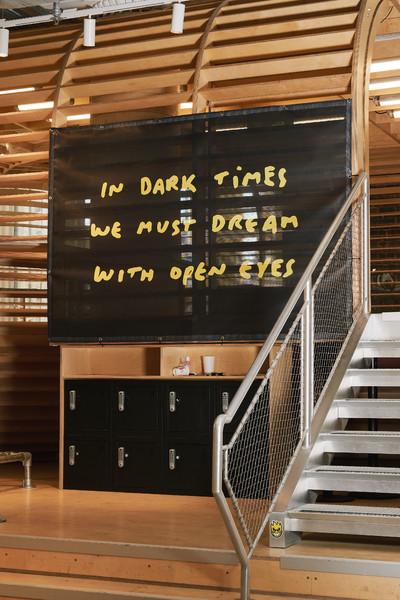
Where are you based?
Nico Vascellari: Vittorio Veneto.
Describe what you do.
Nico Vascellari: I’m an artist and I run the Codalunga cultural space in Vittorio Veneto.
Please describe your concept. What are your stylistic ambitions and references?
Nico Vascellari: If that was indeed not a pipe – and I would certainly agree on that – then what I make with Codalunga are not T-shirts but rather flags. And flags are flags anyhow.
What does your installation for SUPERFUTURES say about the future?
Nico Vascellari: To dream about a better future is a natural drive – and to act in the present for a better future should be natural, too.
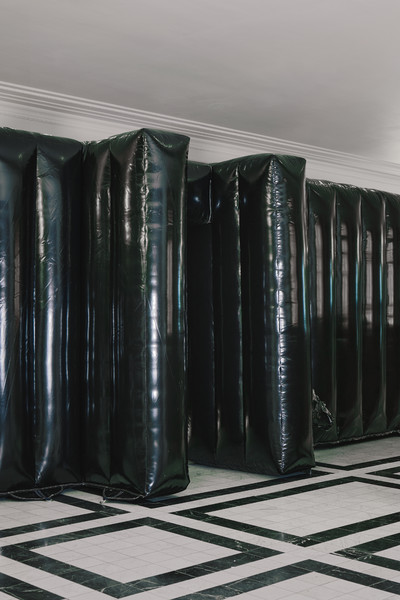
Where are you based?
Jan Vorisek: Zürich.
Describe what you do.
Jan Vorisek: Artist.
Please describe your concept. What are your stylistic ambitions and references?
Jan Vorisek: Devotion Strategy (2020-2022) is a pneumatic, dungeon labyrinth-like padded cell made of pitch-black PVC ‘to be taken home, inflated and folded together once again’. It is only a short step from the sublime to the ridiculous, just as from sublimity to violence, where the fetish becomes an aesthetic and a ‘movement of things’. By means of speculative samples of the impermanent, we are kept in a cheerful mood by this feeling. Not only in the area of the actual object but – similar to a monstrous, undead object-libido going by the name of lamella3 – it may also be found in its unavoidable entanglement with his- tory and with fate. In the predictable, repeated ruin of a plastic body subsiding into itself, a discarded snake slough, which when the air pump is turned off, lies limply as if dead.
What does your installation for SUPERFUTURES say about the future?
Jan Vorisek: Transcendental annihilation.
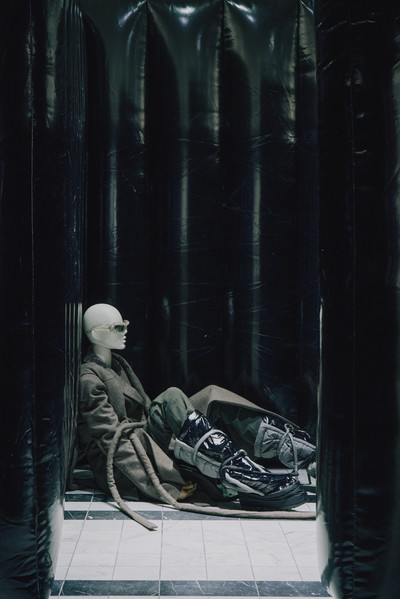
Where are you based?
Ottolinger: Berlin.
Describe what you do.
Ottolinger: Designers.
Please describe your concept. What are your stylistic ambitions and references?
Ottolinger: To wear Ottolinger is to enter the world like a car alarm, moving in an operatic blaze. The pieces from Autumn/Winter 2022 are not only a call to attention, but a complete transformation of space. To wear Ottolinger is to walk through that door holding that purse, placing it on the bevelled-glass table just as the pen is pressed to paper. Contracts signed. Doors opened. Slippery materials forming a rugged, new hyper reality. Ottolinger Autumn/Winter 2022 is the final layer of a dizzying membrane that catches the sun, enabling performance and drama to shimmer shoulder to shoulder. To wear Ottolinger is to be cloaked in confidence; it is a second skin, tied in an endless knot of amplification.
What does your installation for SUPERFUTURES say about the future?
Ottolinger: Be unafraid. Occupy space. Raise the alarm.
A series of experiential spectacles and surreal interventions by leading artists, brands and thinkers, SUPERFUTURES will be held from 14 July to 16 October across 3 floors of Selfridges at 400 Oxford St, London W1A 1AB and on www.selfridges.com.